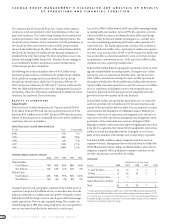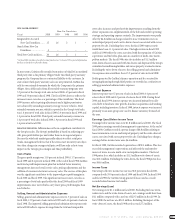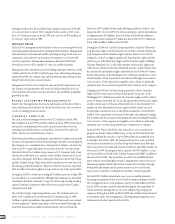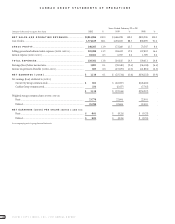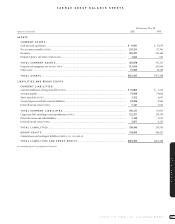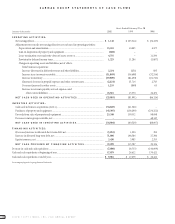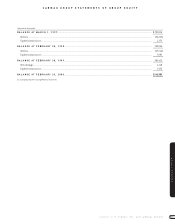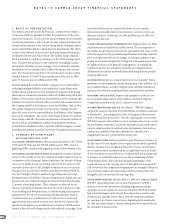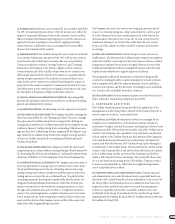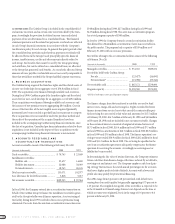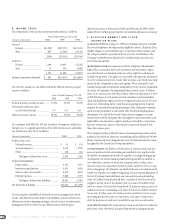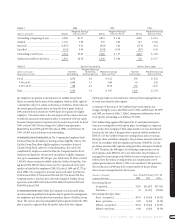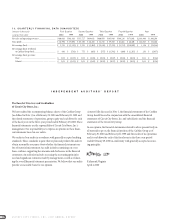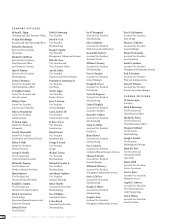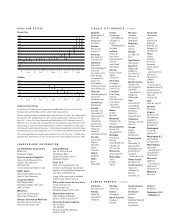CarMax 2000 Annual Report Download - page 76
Download and view the complete annual report
Please find page 76 of the 2000 CarMax annual report below. You can navigate through the pages in the report by either clicking on the pages listed below, or by using the keyword search tool below to find specific information within the annual report.
CIRCUIT CITY STORES, INC. 2000 ANNUAL REPORT
74
(C) INCOME TAXES: The CarMax Group is included in the consolidated fed-
eral income tax return and in certain state tax returns filed by the Com-
pany. Accordingly, the provision for federal income taxes and related
payments of tax are determined on a consolidated basis. The financial
statement provision and the related tax payments or refunds are reflected
in each Group’s financial statements in accordance with the Company’s
tax allocation policy for such Groups. In general,this policy provides that
the consolidated tax provision and related tax payments or refunds will
be allocated between the Groups based principally upon the financial
income,taxable income,credits and other amounts directly related to
each Group. Tax benefits that cannot be used by the Group generating
such attributes,but can be utilized on a consolidated basis,are allocated
to the Group that generated such benefits. As a result,the allocated Group
amounts of taxes payable or refundable are not necessarily comparable to
those that would have resulted if the Groups had filed separate tax returns.
4. BUSINESS ACQUISITIONS
The CarMax Group acquired the franchise rights and the related assets of
six new-car dealerships for an aggregate cost of $34.8 million in fiscal
2000. The acquisitions were financed through available cash resources.
During fiscal 1999, CarMax acquired the franchise rights and the related
assets for four new-car dealerships for an aggregate cost of $49.6 million.
These acquisitions were financed through available cash resources and
the issuance of two promissory notes aggregating $8.0 million. Costs in
excess of the fair value of the net tangible assets acquired (primarily
inventory) have been recorded as goodwill and covenants not to compete.
These acquisitions were accounted for under the purchase method and
the results of the operations of the acquired franchises have been
included in the accompanying CarMax Group financial statements since
the date of acquisition. Unaudited pro forma information related to these
acquisitions is not included as the impact of these acquisitions on the
accompanying CarMax Group financial statements is not material.
5. ACCOUNTS RECEIVABLE AND
SECURITIZATION TRANSACTIONS
Accounts receivable consist of the following at February 29 or 28:
(Amounts in thousands) 2000 1999
Trade receivables............................................ $ 70,763 $ 23,649
Installment receivables:
Held for sale.............................................. 23,477 14,690
Held for investment .................................. 22,088 38,093
Retained interests..................................... 18,743 26,145
Total accounts receivable................................ 135,071 102,577
Less allowance for doubtful accounts ............ 5,818 5,213
Net accounts receivable.................................. $129,253 $ 97,364
In fiscal 1996,the Company entered into a securitization transaction on
behalf of the CarMax Group to finance the installment receivables gener-
ated by the Group’s wholly owned finance operation. A restructuring of
the facility during fiscal 1997 resulted in the recourse provisions being
eliminated. Proceeds from the auto loan securitization transaction were
$348 million during fiscal 2000, $271 million during fiscal 1999 and
$123 million during fiscal 1998. This auto loan securitization program
has a total program capacity of $500 million.
In October 1999,the Company formed a second securitization facility
that allowed for a $644 million securitization of auto loan receivables in
the public market. The program had a capacity of $559 million as of
February 29, 2000, with no recourse provisions.
Receivables relating to the securitization facilities consist of the following
at February 29 or 28:
(Amounts in thousands) 2000 1999
Managed receivables.................................. $ 931,745 $589,032
Receivables held by the CarMax Group:
For sale................................................. (23,477) (14,690)
For investment* ................................... (21,096) (35,342)
Net receivables sold.................................... $ 887,172 $539,000
Program capacity....................................... $1,059,500 $575,000
*Held by a bankruptcy remote special purpose company
The finance charges from the transferred receivables are used to fund
interest costs,charge-offs and servicing fees. Rights recorded for future
finance income from serviced assets that exceed the contractually speci-
fied servicing fees are carried at fair value and amounted to $15.5 million
at February 29, 2000, $14.7 million at February 28,1999,and $6.8 million
at February 28,1998,and are included in net accounts receivable. Changes
in these retained interests consisted of originated retained interests of
$17.5 million in fiscal 2000,$16.6 million in fiscal 1999 and $7.3 million
in fiscal 1998,less amortization of $16.7 million in fiscal 2000,$8.7 million
in fiscal 1999 and $3.6 million in fiscal 1998. The finance operation’s ser-
vicing revenue totaled $36.9 million for fiscal 2000,$28.2 million for fiscal
1999 and $11.2 million for fiscal 1998. The servicing fee specified in the
auto loan securitization agreements adequately compensates the finance
operation for servicing the accounts. Accordingly,no servicing asset or
liability has been recorded.
In determining the fair value of retained interests,the Company estimates
future cash flows from finance charge collections,reduced by net defaults,
servicing cost and interest cost. The Company employs a risk-based pric-
ing strategy that increases the stated annual percentage rate for accounts
that have a higher predicted risk of default. Accounts with a lower risk
profile also may qualify for promotional financing.
The APRs range from 6 percent to 18 percent fixed,with default rates
varying based on credit quality, but generally aggregating 0.75 percent to
1.25 percent. The weighted average life of the receivables is expected to be
in the 18 month to 20 month range.Interest cost depends on the time at
which accounts were originated,but is in the range of 6.4 percent to 6.6
percent at February 29,2000.


